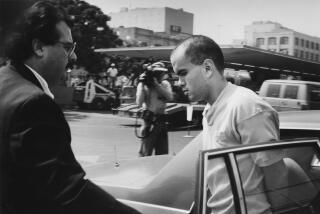Kraft Lawyers Focus on Marine : Defense Begins With Crime That Led to Arrest
Lawyers for Randy Steven Kraft opened their case Monday by focusing on the most dramatic of the 16 murder charges against him: the one involving a dead Marine found in Kraftâs car when he was arrested 5 years ago.
In quick succession, three acquaintances of 25-year-old Terry Lee Gambrel helped establish that the victim had been a big man, about 6 feet, 1 inch,and more than 200 pounds, who could handle himself in a fight.
The implication was clear: Gambrel was too large and too capable of defending himself to let Kraft, at 5-10 and 165, overpower him.
âI wouldnât want to trifle with him,â said Michael Such, an ex-Marine who had been stationed with Gambrel at the El Toro Marine Corps Air Station.
Kraft, 43, is on trial in Santa Ana before Superior Court Judge Donald A. McCartin in what could be the most costly criminal proceeding in state history, according to many legal experts. While Kraft is formally charged with 16 killings, prosecutors have accused him in court papers of being responsible for at least 45 deaths of young men. And if a list found in Kraftâs car is indeed a coded score card of his victims, prosecutors say, the death toll would amount to 65. That would make Kraft the worst serial killer in the country.
New 3-Piece Suit
Deputy Dist. Atty. Bryan F. Brown has said that if Kraft is convicted he will seek the death penalty, and will outline up to 29 other alleged killings during the trialâs penalty phase.
Kraft walked into the courtroom in a new three-piece light brown suit, carrying a stack of legal papers. He smiled slightly as he glanced at the audience and then quickly sat down. He never turned around again.
The court session was the first since Nov. 30, when Kraftâs lawyers received what became a 2-month recess to better prepare his defense. Prosecutors had opened their case in September, amid considerable media attention. But media and general public interest dwindled to a trickle as prosecutor Brown continued the methodical task of presenting criminalists and law enforcement officers on each of the 16 counts.
Mondayâs defense testimony drew more than the usual number of onlookers. But at least one observer expressed disappointment when he left the courthouse after the morning session.
âI was expecting something a lot more dramatic,â said the man, who asked not to be identified.
âYou watch too much television,â quipped a companion.
Kraft, a computer expert from Long Beach, was arrested on May 14, 1983, by two California Highway Patrol officers who stopped him on the San Diego Freeway in Mission Viejo when they suspected that he was driving drunk.
The CHP officers discovered Gambrel stretched out in the front passenger seat of the car. Both have testified that they were certain he was dead. He had a strangle mark on his neck, and faint marks on his wrists where he had been tied up. His pants were down and he was barefoot. His belt and his shoelaces--which had been knotted and cut--were found in the back-seat area.
Prosecutors claim Gambrel was strangled with the belt, and that the laces from his tennis shoes were used by Kraft to bind his wrists.
Prosecutors contend that Kraft was able to overpower the larger Gambrel by weakening his defenses with drugs and alcohol. Criminalists have testified that a combination of drugs and alcohol were found in Gambrelâs system.
The drug was a depressant known as Ativan, according to expert testimony. An Ativan prescription in Kraftâs name was in the car. And beer was found in a cooler in the back seat.
Besides noting Gambrelâs large stature, Kraft attorney C. Thomas McDonald attempted to establish for jurors that Gambrel had used drugs before ever getting into Kraftâs car.
Another ex-Marine witness, Robert M. Hammond, testified that he knew âthrough the grapevineâ that Gambrel was under investigation for drug use by authorities at the El Toro Marine base where they were stationed.
At one point, Hammond claimed it was common knowledge at the time of Gambrelâs death in 1983 that more than half the Marines at the El Toro base were using drugs.
âYouâd have to be dead not to notice,â Hammond said.
Kraft watched the witnesses with a pen in hand and occasionally whispered to his lawyers.
In the afternoon session, Kraftâs attorneys questioned one of the paramedics who had attended to Gambrel at the arrest scene. The defense contends that Gambrel was still alive when discovered by the CHP officers.
The paramedic, Jerry Flores, said that his team injected a stimulant into Gambrelâs body and that electrical impulses ran through his heart. But they were unable to revive him.
âBut there were some signs of viability that caused you to believe this individual needed paramedics, thatâs right?â McDonald asked.
Yes, Flores said.
âYou believed (at the time) he might have benefited from paramedic services?â
Flores again replied yes.
But on cross-examination by prosecutor Brown, Flores confirmed that the paramedics never got a heart response from Gambrel at any time, and that electrical impulses are possible after death.
After Flores, Kraftâs attorneys questioned several crime lab and Orange County Sheriffâs Department officials who were involved with the Gambrel investigation. For senior criminalist James M. White, it was the seventh appearance to testify in the case since the trial began.
White told the jurors that he had inspected a buck knife found on the front seat of Kraftâs car for blood or fibers, but had found none. McDonald quickly pointed out to jurors through his questions that no fibers from the cut shoelaces were found on the knife.
Prosecutor Brown countered by getting White to say that a lack of fibers on the knife did not mean the knife was not used to cut the shoelaces.
The first day of the defense testimony ended with the senior investigator on the case, Sheriffâs Sgt. James A. Sidebotham. This was only Sidebothamâs second time to testify during the trial. But he had spent more than 3 months on the stand during a pretrial search-warrant hearing in the case.
McDonald began to question him about a letter the department had received from someone named Les, confessing to a series of murders of young men in Orange County.
Les stated that âI am the new Zodiac . . . come to liquidate the evil boys and men of this area. My method will or has been the rope.â
Law enforcement officials have viewed the Les letter as a fake. Sidebothamâs testimony is scheduled to continue at 10 a.m. today.
More to Read
Sign up for Essential California
The most important California stories and recommendations in your inbox every morning.
You may occasionally receive promotional content from the Los Angeles Times.










